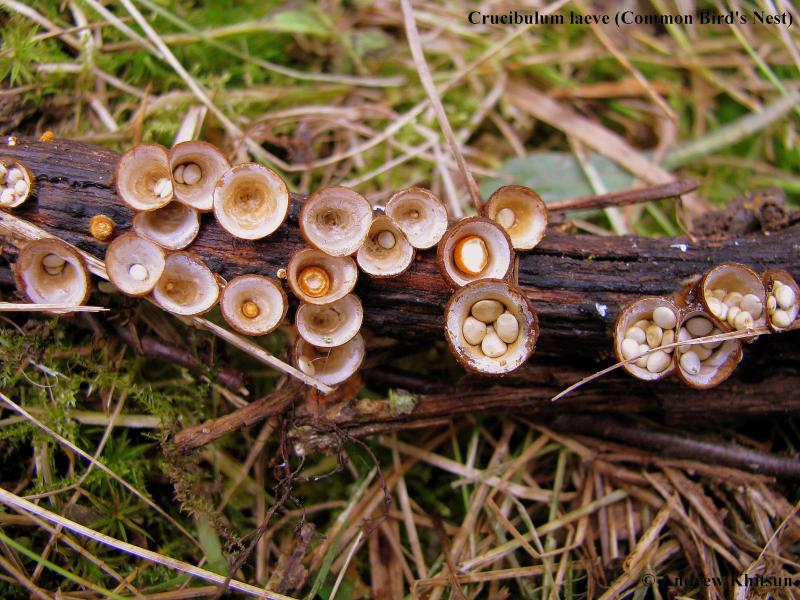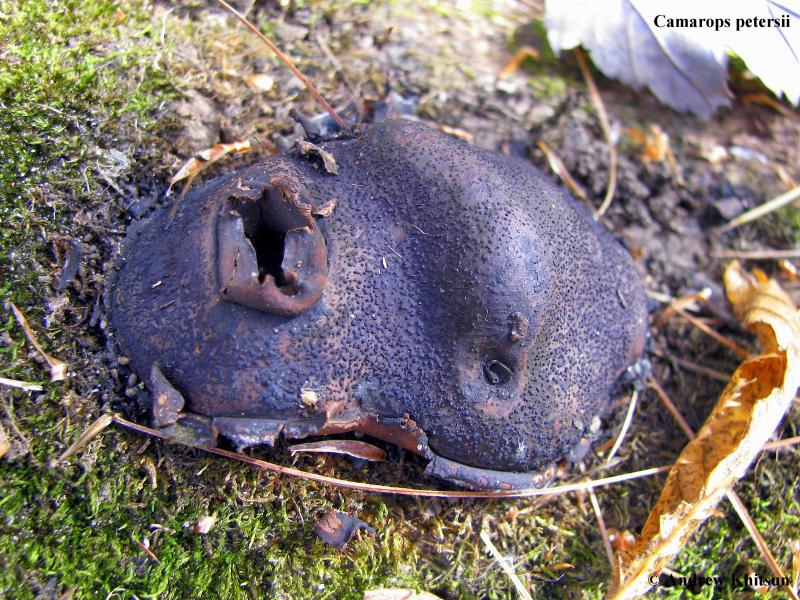|
Crucibulum laeve
[ Basidiomycota > Agaricales > Agaricaceae > Crucibulum . . . ] by Michael Kuo Crucibulum laeve is probably the most common and frequently encountered bird’s nest fungus in temperate North America. Three features serve to identify it successfully: its yellowish colors; the “lid” over the nest (in young specimens), covering the eggs; and the tiny cords that attach the eggs to the nest. Observing this last feature requires some patience with a very tiny tool–say, a needle or a pin–and a hand lens. The cord, which is called a “funiculus” in Mycologese, is the egg’s mechanism for attaching itself to sticks, leaves, and other plant debris. When a raindrop falls into the nest, the eggs are projected out of the cup. As this happens, the cord is stretched to its limit–then breaks away from the nest, remaining attached to the egg. Where the cord was attached to the nest, it becomes frayed, since it was torn away. The little frayed ends are adhesive, and when they come into contact with, for example, a leaf, they attach themselves. This stops the flight of the egg, which then swings back and attaches itself to the leaf as well . . . rather like what would happen to a kite if you were to let it sail away after coating your end of the string with glue. Description: Ecology: Saprobic; growing alone, scattered, or densely gregariously on woodland debris (sticks, leaves, nutshells, needles, etc.), woodchips, old furniture, dung, and so on (but not typically on the ground alone or on larger logs); spring through fall (or in winter in warmer climates); widely distributed in North America. Nest: 2-9 mm high; 4-10 mm across; at first cushion-shaped to round, and closed by a mustard yellow to dull yellow “lid”; later becoming cup-shaped or goblet-shaped, the lid disappearing; outer surface yellowish at first, remaining yellow or darkening to nearly brown, velvety or fairly bald; inner surface bald and shiny, whitish to grayish. Eggs: To 2 mm wide; shaped like flattened circles or ellipses; tough; attached to the nest by tiny cords; pale tan to buff. Microscopic Features: Spores 6-9 x 3-5 µ; smooth; elliptical. REFERENCES: (Hudson, 1778) Kambly, 1936. (Saccardo, 1888; Brodie, 1975; Smith, Smith & Weber, 1981; Arora, 1986; States, 1990; Phillips, 1991/2005; Lincoff, 1992; Horn, Kay & Abel, 1993; Evenson, 1997; Barron, 1999; Roody, 2003; McNeil, 2006; Miller & Miller, 2006.) Herb. Kuo 06079601, 06300703, 06080801, 06121302 Kuo, M. (2014, February). Crucibulum laeve. Retrieved from the MushroomExpert.Com Web site: http://www.mushroomexpert.com/crucibulum_laeve.html [Ascomycetes > Boliniales > Boliniaceae > Camarops . . . ]by Michael Kuo
Have you ever seen those ridiculous “faces” that people put on trees in their yards? This mushroom represents what would happen if the Addams Family got hold of the idea. It’s creepy and its kooky, mysterious and spooky. It’s altogether ooky . . . Camarops petersii. For more of Uncle Fester’s lawn decorations, see Pisolithus tinctorius and Scleroderma polyrhizum. Camarops petersii looks like a bulging black eye, complete with eyelids, stuck to the side of a dead log. The eyelid is a veil that protects the young mushroom but soon ruptures to expose the spore-producing surface. The range of Camarops petersii in North America extends from eastern North America to at least Kansas and Cuba. Description: Ecology: Saprobic on the decorticated wood of fallen oaks (early records for the species also included wood of the now extinct American chestnut as a substrate); growing alone or in small clusters; late summer and fall; eastern North America to Kansas and Cuba. Fruiting Body: 2-7 cm wide; up to about 2 cm high; sub-circular or broadly elliptical in outline; cushion-shaped, with a somewhat narrowed base; upper surface black and shiny, covered with pimple-like dots (and covered with black slime when the mushroom is producing spores); encased in a black, feltlike veil that soon ruptures and becomes a sheath around the sides of the fruiting body, with a ragged upper edge; interior tough and brownish, filled with black channels and pockets but not featuring concentric zones. Chemical Reactions: Tissues from dried specimens brownish when crushed in KOH. Microscopic Features: Asci 8-spored; deliquescing along with the paraphyses so that spores are exuded from the perithecia in a gelatinous black matrix (according to Nannfeldt [1972], “[t]he ascus has lost its gun function”). Spores 6-8.5 x 3-4.5 µ smooth; broadly elliptical at one end and broadly fusiform at the other; with a tiny pore at the narrowed end; usually biguttulate in KOH or water mounts; purplish gray in KOH. REFERENCES: (Berkeley & Curtis, 1868) Nannfeldt, 1972. (Saccardo, 1882; Nannfeldt, 1972; Horn, Kay & Abel, 1993.) Herb. Kuo 10160407, 09190602. Kuo, M. (2007, February). Camarops petersii. Retrieved from the MushroomExpert.Com Web site: http://www.mushroomexpert.com/camarops_petersii.html |
|
If You Suspect a Poisoning
If you suspect you have consumed a poisonous mushroom, contact a physician, the closest hospital ER, poison control center, or dial 911, depending on the severity of the reaction. US Poison Control: 1-800-222-1222 The North American Mycological Association (NAMA) has information that may also be of help. Click here. We do not ID mushrooms through this website.
If you are in need of an ID consider uploading quality photos with multiple views of your specimen and descriptions of your find to Mushroom Observer or iNaturalist including our projects or post in Wild Food Wisconsin or Mushroom Identification Group. If you contact us and provide a way to get back to you, we may be able to provide suggestions for more identification resources you can use. You are always responsible for your own decisions taken on the basis of identification resources. |
Wisconsin Mycological Society (WMS) is dedicated to the study and enjoyment of mushrooms and other fungi throughout the state of Wisconsin. Education, safety, sustainability, community, and connecting with nature are our goals.
|



 RSS Feed
RSS Feed
